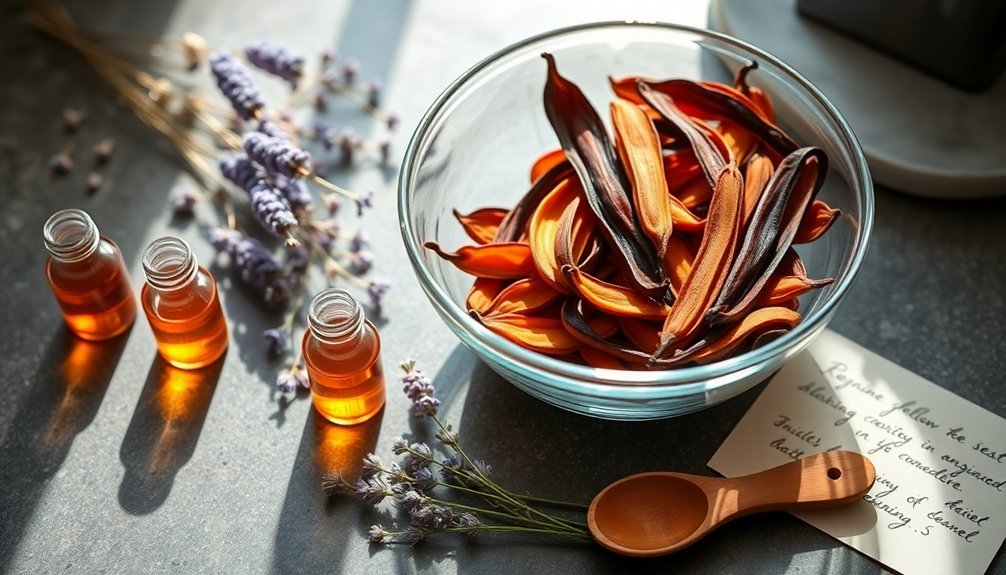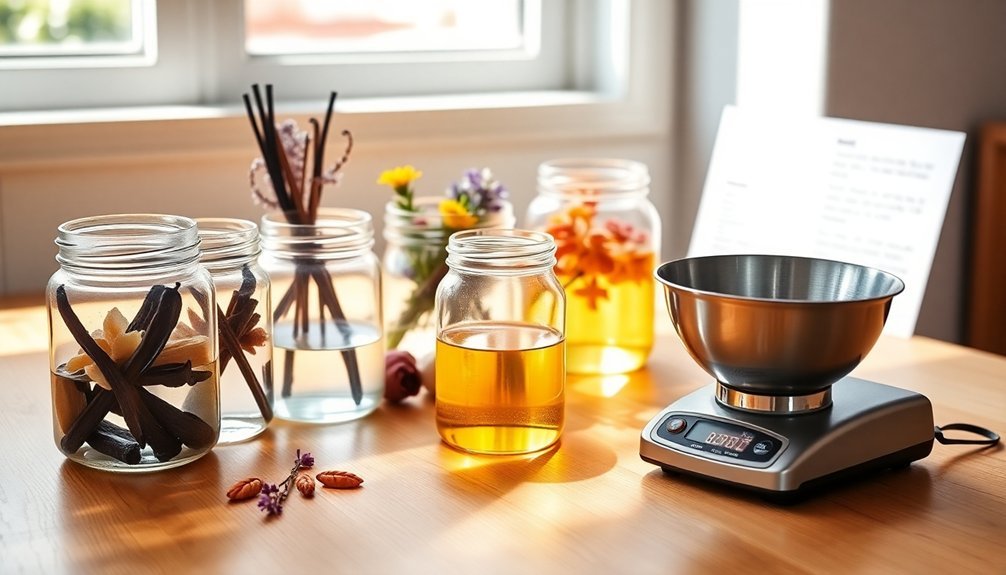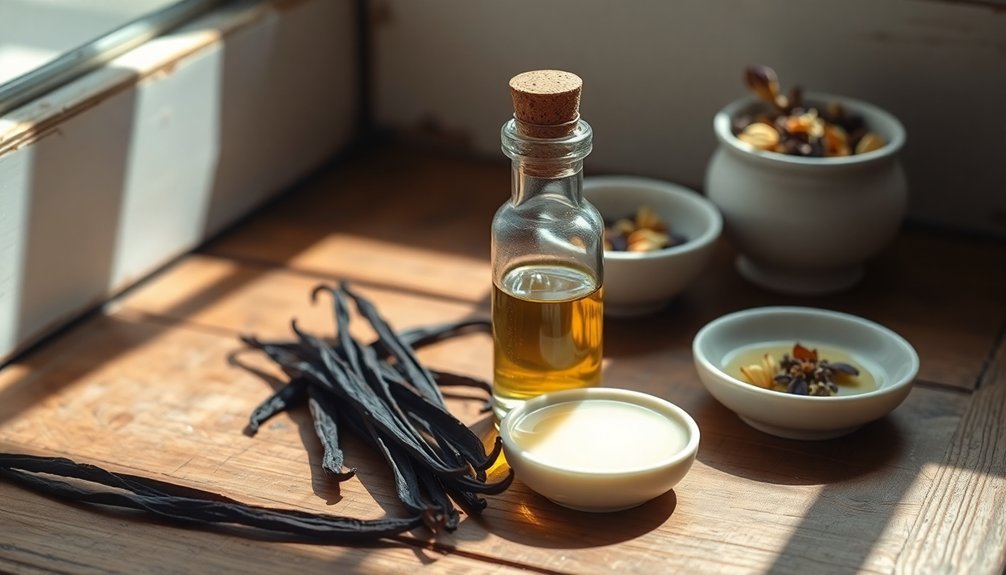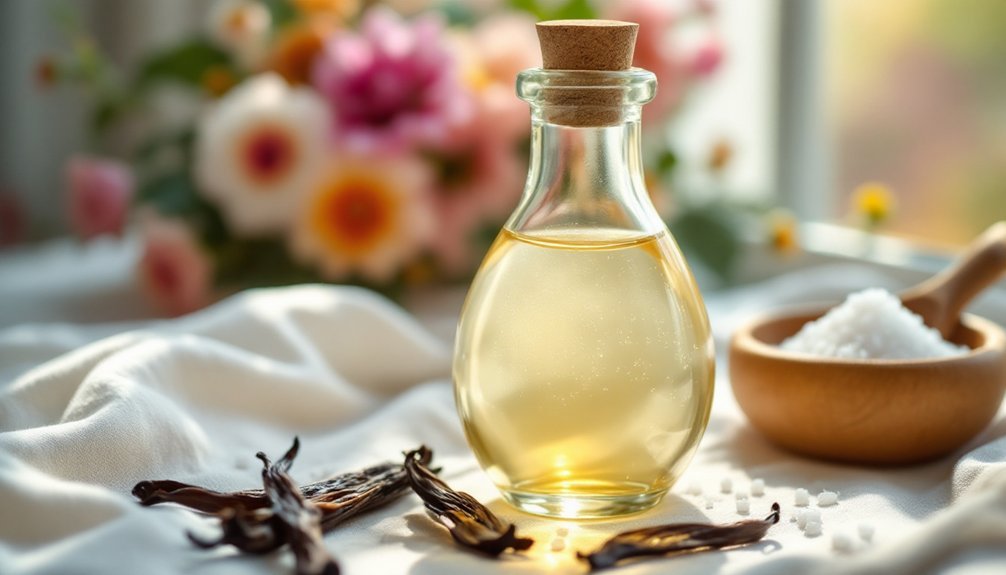You can make your own alcohol-free vanilla perfume using simple ingredients like vanilla beans or extract, and a carrier oil like jojoba or sweet almond oil. Combine the vanilla with your chosen carrier oil in a small bowl, stir well, and let it mature for 48 hours in a dark glass container. Apply to pulse points for the best effect. This natural alternative offers a gentle, customizable fragrance – and there's so much more to explore about enhancing your signature scent.
Why Choose Natural Vanilla Perfume

While commercial fragrances flood the market with synthetic alternatives, natural vanilla perfume offers a compelling blend of aromatherapy benefits and environmental consciousness.
You'll experience the genuine comfort of a scent that adapts uniquely to your body chemistry while avoiding harsh synthetic chemicals.
Natural vanilla perfume doesn't just make you smell good – it improves your well-being. The aromatic compounds help reduce stress, enhance mood, and promote better sleep quality. Hand-pollinated vanilla beans make this fragrance particularly precious and rare.
You're also supporting sustainable farming practices and local communities when you choose natural vanilla. Plus, your skin benefits from the antioxidant properties found in pure vanilla oil.
The timeless appeal of vanilla connects you to centuries of traditional use, offering both therapeutic benefits and cultural significance that synthetic alternatives simply can't match.
Essential Ingredients and Tools
Creating your own vanilla perfume starts with gathering the right ingredients and tools.
Start your DIY perfume journey by assembling essential ingredients and tools for a homemade vanilla fragrance.
You'll need either vanilla beans or vanilla extract as your primary scent component, along with a carrier oil like jojoba or sweet almond oil to dilute it properly. Optional essential oils such as lavender, bergamot, or sandalwood can enhance your fragrance blend.
For tools, you'll want to have dark glass containers to protect your perfume ingredients from light degradation. You'll also need glass containers for steeping and storage, a fine mesh sieve for straining, and cheesecloth for filtering.
Don't forget measuring cups and spoons for precise ratios, and dark glass perfume bottles to protect your final creation from light exposure.
If you're looking to customize your scent, consider adding glycerin for moisture or experimenting with alternative carrier oils like fractionated coconut oil or grapeseed oil.
Step-by-Step Making Process

Once you've gathered all your ingredients, the vanilla perfume-making process begins with careful measurements and precise mixing.
Start by combining your vanilla essential oil with your chosen complementary oils in a small bowl. Next, gradually add your carrier oil, stirring thoroughly to guarantee even distribution.
Pour your mixture into a clean jar and let it sit for 48 hours to mature. Using vanilla in perfumes can provide calming effects, similar to its aromatherapy benefits.
If you're using vanilla beans, scrape the seeds into your carrier oil and warm it slightly before transferring to a jar. Allow this infusion to steep for at least a week in a cool, dark place.
After steeping, strain out any solid particles and transfer your perfume to your chosen container. Test the fragrance on your skin and adjust the blend if needed by adding more oils.
Storage and Shelf Life Tips
Store your homemade vanilla perfume in a dark amber glass bottle with an airtight seal to protect it from light damage and oxidation.
You'll want to keep your creation in a cool, dark spot away from heat sources and humidity, maintaining a stable temperature between 60-70°F.
While your vanilla perfume doesn't technically expire, you can extend its life by minimizing exposure to air and handling the bottle gently during use.
Proper Container Selection
The success of your homemade vanilla perfume largely depends on proper container selection and storage methods. You'll want to choose dark or amber glass bottles that protect your fragrance from light degradation while maintaining its potency.
| Container Type | Benefits | Best For |
|---|---|---|
| Amber Glass | Maximum UV protection | Long-term storage |
| Dark Glass | Good light filtering | Daily use |
| Ceramic | Temperature stability | Display pieces |
| Metal | Durability | Travel containers |
| Roller Bottles | Easy application | Personal use |
Make sure your chosen container has an airtight seal to prevent evaporation and contamination. Before filling, thoroughly clean your container and consider adding a label with the creation date and ingredients. You'll find that proper container selection not only preserves your perfume's quality but also enhances its presentation and usability.
Temperature Control Matters
Now that you've selected the ideal container, maintaining proper temperature control is your next key step for perfume longevity. Your homemade vanilla perfume will stay fresh longest when stored between 15°C and 20°C (59°F-68°F) in a cool, dry place away from direct sunlight and humidity.
- Store your perfume in a bedroom drawer or cupboard, not in bathrooms or kitchens.
- Keep the bottle in its original packaging for extra protection against light and temperature changes.
- Avoid exposing your perfume to temperature fluctuations, which can separate ingredients.
- Place bottles on low shelves to prevent accidental drops and minimize movement.
- Maintain storage areas with humidity levels below 50% to preserve fragrance integrity.
These storage practices will help maintain your vanilla perfume's aromatic qualities and extend its shelf life considerably.
Extending Fragrance Life
Protecting your homemade vanilla perfume's delicate composition requires strategic storage practices beyond basic temperature control.
Store your creation in a dark amber or opaque glass bottle, and keep it in its original box for added protection against light exposure. Don't display your perfume on windowsills or decorative shelves where sunlight can degrade its quality.
You'll want to minimize air exposure by ensuring the bottle cap remains tightly sealed when not in use. Consider using smaller bottles to reduce oxidation during regular applications.
Check your perfume weekly for any signs of discoloration or changes in scent, particularly since natural vanilla ingredients can be sensitive to environmental factors.
For best results, store your perfume in a cool, dry cabinet or drawer where conditions remain stable and humidity stays low.
Customizing Your Vanilla Fragrance
Creating your own signature vanilla perfume opens up endless possibilities for personalization.
You'll want to start with pure vanilla beans for an authentic aroma, or use vanilla extract as a convenient alternative. Choose your preferred carrier oil – jojoba, sweet almond, or fractionated coconut oil work well as bases.
To create unique scent combinations, experiment with complementary essential oils that blend beautifully with vanilla.
- Combine with lavender and bergamot for a soothing, balanced fragrance
- Mix with jasmine and rose for an elegant floral bouquet
- Add citrus oils like lemon or orange for a bright, uplifting scent
- Blend with sandalwood for a warm, sophisticated aroma
- Include cinnamon or clove for a spicy, comforting variation
Remember to let your blend mature for at least a week to achieve the best possible fragrance.
Common Mistakes to Avoid

You'll want to carefully measure and balance your ingredient ratios, as using too much or too little of any component can leave you with an overwhelming or weak vanilla fragrance.
When storing your homemade perfume, keep it in dark amber or cobalt blue glass bottles to protect against light degradation.
Never leave your perfume exposed to direct sunlight or high temperatures, as these conditions can quickly break down the fragrance and reduce its shelf life.
Poor Ingredient Ratios
Three critical mistakes can derail your homemade vanilla perfume before you even begin blending. When you don't balance your base notes properly, your vanilla perfume won't have the depth it needs.
Similarly, using too many top notes can make your fragrance overwhelming at first but fade quickly. You'll also run into trouble if you don't properly dilute your vanilla absolute in carrier oil.
Key ratio mistakes to watch for:
- Using too little cedarwood or sandalwood as supporting base notes
- Adding excessive amounts of citrus oils like bergamot or wild orange
- Not including enough mid-notes like rose or lavender for complexity
- Failing to properly measure your carrier oil proportions
- Overdoing the musk concentration, which can overpower the vanilla
Improper Storage Methods
While crafting the perfect vanilla perfume requires precise measurements and quality ingredients, proper storage is equally essential for maintaining its integrity.
You'll want to avoid common storage mistakes that can quickly degrade your creation. Never store your vanilla perfume near windows or in bright areas, as UV rays will break down the fragrance compounds.
Keep your perfume away from your bathroom, where temperature fluctuations and humidity can trigger unwanted chemical reactions. Instead, store your creation in a dark glass bottle, tightly sealed, in a cool, dry place that maintains a steady temperature between 60°F and 70°F.
Don't shake the bottle; gentle rotation will help preserve the scent. If you must store it near a window, use UV-filtering curtains to protect your perfume.
Best Practices for Application
Achieving the perfect fragrance application begins with understanding the key principles of perfume use.
You'll want to apply your vanilla perfume to clean, moisturized skin, focusing on pulse points where body heat will naturally diffuse the scent. Apply your perfume right after a shower when your skin is warm and receptive to the fragrance.
- Target pulse points like wrists, neck, and behind ears
- Start with a small amount to avoid overwhelming yourself and others
- Confirm your skin is properly moisturized before application
- Allow the fragrance to develop naturally throughout the day
- Test the perfume's strength on a small skin area first
Remember to be mindful of the fragrance's intensity and avoid applying near your eyes or sensitive areas.
Your perfume will evolve differently based on your body chemistry, so give it time to settle.
Natural Fragrance Combinations

Creating enchanting natural fragrances depends on understanding essential oil combinations and their unique characteristics.
For your vanilla perfume, you'll find that vanilla pairs beautifully with several complementary scents. Try blending it with lavender for a calming, serene aroma that's perfect for everyday wear. If you're looking for something warmer, combine vanilla with spicy notes like cinnamon or ginger for a cozy, comforting scent.
You can also enhance your vanilla base with floral elements. Rose geranium adds a sophisticated touch, while jasmine creates an elegant, complex fragrance.
For a year-round signature scent, consider adding woody notes like cedarwood or sandalwood to your vanilla blend. These combinations will give your homemade perfume depth and character while maintaining the natural, pure qualities of essential oils.
Frequently Asked Questions
Can I Use Imitation Vanilla Extract Instead of Real Vanilla Beans?
You shouldn't use imitation vanilla extract, as it won't give you the authentic scent and depth you're looking for. It's synthetic, lacks natural complexity, and won't blend well with other ingredients.
Will the Perfume Stain My Clothes or Jewelry?
You'll face minimal staining risks with proper application. Let the perfume dry completely before dressing, and avoid direct contact with jewelry. If stains occur, treat them immediately with cold water and regular washing.
How Do I Remove Vanilla Perfume From Skin if Needed?
You can remove vanilla perfume by applying baking soda paste, using mild oils like almond or jojoba, or trying makeup remover. You'll also find that white vinegar or lemon juice effectively neutralizes the scent.
Can I Reuse the Vanilla Beans After Making Perfume?
You can reuse vanilla beans, but they'll be less potent with each use. While they're suitable for making vanilla sugar or flavoring dishes, you'll get weaker fragrance results in subsequent perfume batches.
Why Does My Homemade Vanilla Perfume Smell Different From Commercial Versions?
Your homemade vanilla perfume smells different because commercial versions use concentrated vanilla absolutes, specialized extraction methods, and complex blending techniques. They'll also include additional fragrance notes and stabilizing ingredients you can't replicate at home.





Leave a Reply